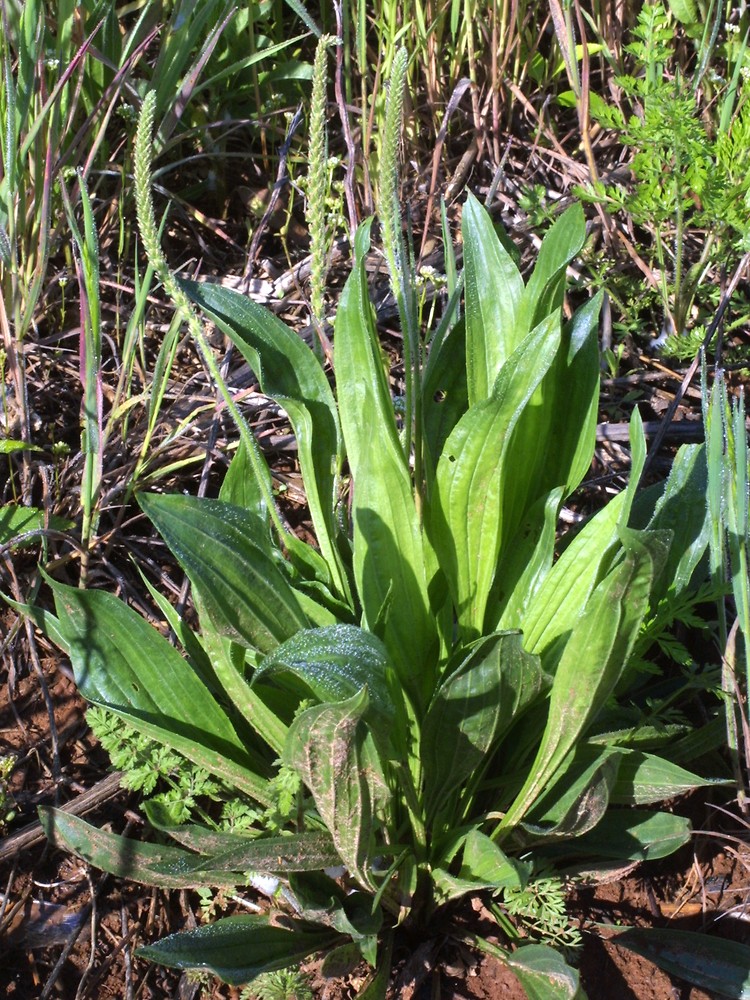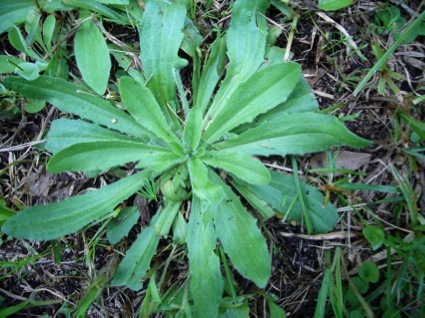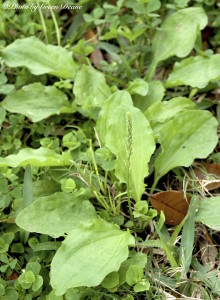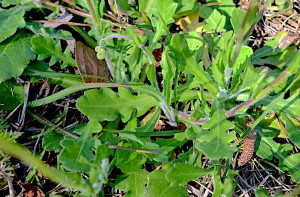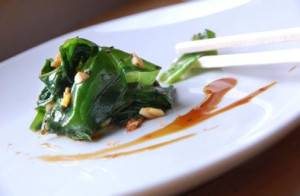White man’s Little Foot: Dwarf Plantain
Plantagos To Go
When I was about 10 a bee stung my hand while I was being a pest in the garden with my father. My hand began to swell and I started to complain, to put it gently. My father picked a large Plantago major leaf, chewed it up, and stuck the green glob on the sting. I can’t recall if it eased the pain but I never forgot the moment.
Plantago major, (plan-TAY-go MAY-jor) a native of Europe (photo lower left) has been used for food and medicine for a long time. While Plantagos are used the same way I am going to write about its little cousin that’s always under foot, the Dwarf Plantain or Plantago virginica, (plan-TAY-go vur-JIN-nick-uh) which is native to North America. It’s found in most US states excluding the northern Rocky Mountain states. We’ll also look at the P. major, as well. Both are edible, in fact, I have not read of an non-edible plantain.
Getting used to a skinny gray green hairy P. virginica leaf takes time, especially if you’re used to the larger, round, greener, smooth P. major. The P. major is sporadic here in Central Florida, but the P. virginica is quite common but seasonal. I could seed the entire south with the P. virginica in my little lawn alone. And speaking of seeds, the bulking agent psyllium is the husks of a plantago seed. That does need to be qualified slightly. The husk are an insoluble fiber, the seed a soluble fiber. If you order said make sure you know which (or both) you are getting.
As I write it is three quarters of the way through February (there is an full eclipse of the moon tonight, which will date this article.) The local plantains are still in the rosette stage, just starting to send up spikes that will eventually bear seeds. The leaves are mild in flavor now and though it takes a lot of them to make a side dish for one, they are tasty. Later in the season, as with most greens except the Tradescantias, they will grow rank. Plantagos also grow coarse, one of the problems with eating P. major which can be quite fibrous. Fiber is also an element of identification. If you carefully break the lower stem of a Plantago where it meets the rosette, several elastic cords will remain attached. You’ll find three cords to five cords. Other plants — some fleabanes, see photo below right — have cords as well so that is not the sole means of identification.
I think several references on the internet misidentify P. virginica, calling it Plantago lanceolata, or the English Plantain, which one also sees in Florida. That the P. virginica is hairy and has points on its leaves and the P. lanceolata (lan-see-oh-LAY-tuh) does not seem to be overlooked.
Another point to make: The Plantagos are dicots even though they don’t look it. They are visual exceptions to the rule until ones looks very closely. Monocots (unicots) are plants that come out of a seed with only one leaf — mono is Greek for only or alone. They have a rhizome (a horizontal root) instead of a tap root (a vertical root.) Dicots (dio is Greek for two) come out of the seed with two leaves, send down a tap root, and have leaves with veins that branch out. The Plantagos look like monocots but they are dicots. The entire family has some promising medical properties. A study reported in the 30 October 2007 edition of the American Journal of Chinese Medicine demonstrated P. major had tumor inhibiting capacity in lab rats. A tea from the leaves is good for lung congestion and hay fever. As for the name…
The native Indians called the P. major the “white man’s foot” because they notice where ever he went the plant soon showed up. That is quite intuitive, here’s why: Plantain and Plantago both go back to the same Greek word, platus, which means wide, and from which we get “plateau” in English. That is also why some Greek writers think the philosopher Plato had large gluts, he was called Plato because he was wide in the butt. Platus became Planta as in plantar warts. Plantago is a derivative of planta. Plantago became Plantagin in Dead Latin, Plantein in Old French, Plauntein in Middle English and Plantain in modern English. Then P. major came to the new world to have native Americans call it “white man’s foot”…kind of where it started out. It would seem diverse humans think alike. More so, the story doesn’t end there.
Just as P. major invaded North America from Europe, P. virginica is now invading the Orient, having been introduced to eastern China in the 1950s and is spreading to other nations from there, Korea in 1994. One might say that it is spreading by “occident.” The only solution is eat the weeds. See recipes below.
As mentioned above, many folks confuse Oakleaf Fleabane for the Dwarf Plantain. It shows up about the same time, has furry leaves with teeth, and worse, fibers in the stem like plantagos. But it is more lumpy that toothy and it does not have leaf veins that look parallel. Don’t eat it but you can put the leaves in your pet’s bed to reduce fleas.
Lastly, if you find a really huge Plantago major with red at the base of the stem it’s probable the native Plantago rugelii, still useful.
Green Deane’s “Itemized” Plant Profile
IDENTIFICATION: Plantago virginica: Leaves in a rosette, spatulate to oblanceolate or obovate, lightly hairy above and below, lateral veins start at the base of the leaf down the blade, parallel to midrib, shallow occasional tooth on leaf. Stems tall, erect, solid, multiple from the base, not branched. If you have a plant that looks like Plantago major but the bottom of the stem is purple you have P. rugelii.
TIME OF YEAR: Greens in spring, seeds in summer
ENVIRONMENT: Unused fields, pastures, waste ground, lawns, likes full sun
METHOD OF PREPARATION: Young leaves raw in salads, cooked as greens or in soups and stews. Remove fiber in older leaves. Seeds are edible and keep you regular.
HERB BLURB
Herbalists say Plantagos have been used for inflammation of the skin and applied to soars. Fresh leaves are applied whole or bruised. They contain an astringent and help stop minor bleeding. They can also be rubbed on nettle and bee stings.
The first recipe was created by Wildman Steve Brill.
Roasted Plantain Chips
Unlike the banana-related plantain chips of the supermarket, this wafer-thin chips are made with the leaves of the unrelated common plantain. They’re great, and it took Steve only 26 years of downplaying this plants food value to discover how to prepare it properly, using a method his wife uses for kale.
2 cups young common plantain leaves, or kale
2 tsp. sesame oil
1/2 tsp. fennel seeds, ground
1/2 tsp. caraway seeds, ground
1/4 tsp. powdered ginger
1/2 tsp. salt
A dash of hot sauce
1. Stir all the ingredients together
2. Spread onto 3 cookie sheets covered with non-stick mats (or oiled
cookie sheets) and bake about 6 minutes, or until very lightly browned
and crisp, in a preheated 425 degree oven. Stir occasionally, being
careful not to let the leaves burn
And from Christopher Nyerges we have two recipes:
Plantain Soup
3 cups of diced plantains
4 cups of milk or water (milk from powdered milk works as well)
2 eggs
1/2 cup flour, wheat or potato
1 turnip
1 Jerusalem Artichoke
Salt and pepper to taste
Dice the plantains, remove any fibers. Simmer the diced plantains in the milk or water. Chop up the turnip and Jerusalem Artichoke and add to the liquid. In a separate cup add water or milk to the flour to get a non-lumpy consistency, then add to the soup. Separate the eggs and whites, beat separately, add separately to the soup, stirring constantly. Salt and pepper to taste.
Stuffed Plantain Leaf
1 pound ground beef, or the like
2 cups cooked rice
1 clove of garlic
2 lettuce leaves or the like
1 egg, beaten
Boil or steam the plantain leaves, remove any fibers, set aside the leaves. Cook the meat, add the cooked rice and other ingredients. Cook until tender. Place a tablespoon or so of the mixture on each plantain leaf and fold the leaf around the mixture. Place on a baking dish, bake 15 minutes 325, or just enough to warm them up. Salt and pepper to taste.
Plantago Side Dish by Pascal
This is a winner! Broadleaf Plantain leaves boiled for 4 minutes in salted water then placed in ice water right away. Seasoning: 1 tablespoon sesame oil, 1 tablespoon soy, 1 garlic clove and, in my case because I didn’t have sesame seeds I used roasted white sage seeds. Mix and let rest for 5 minutes. Super yum! The plantain has a bit the texture and transparency of a seaweed.
Editor’s note: In this recipe Pascal used Plantago major.

